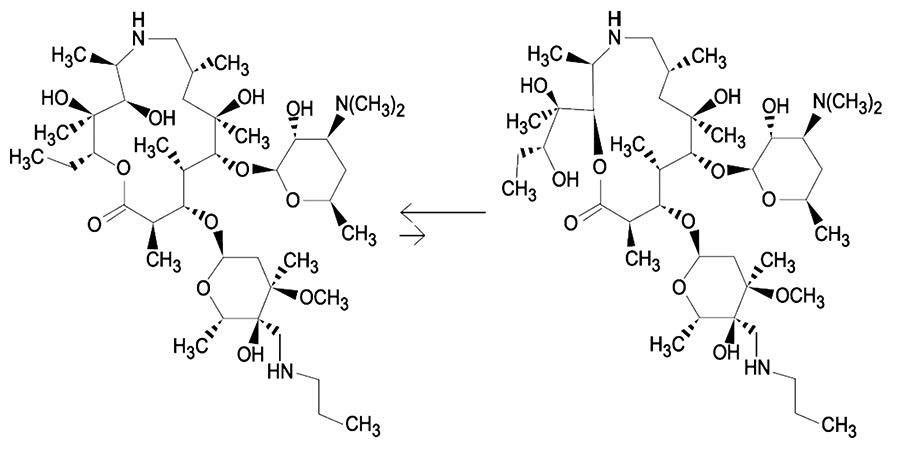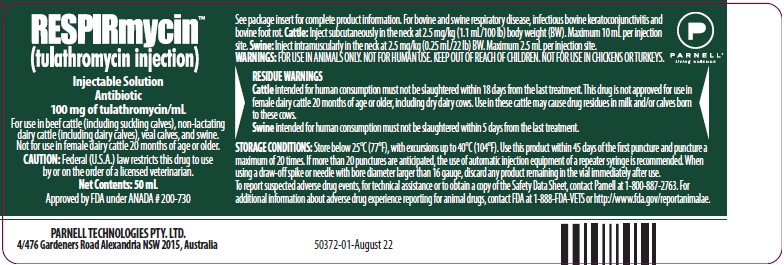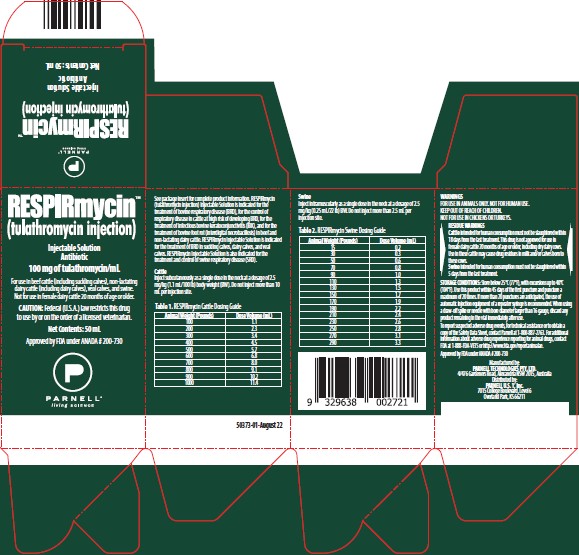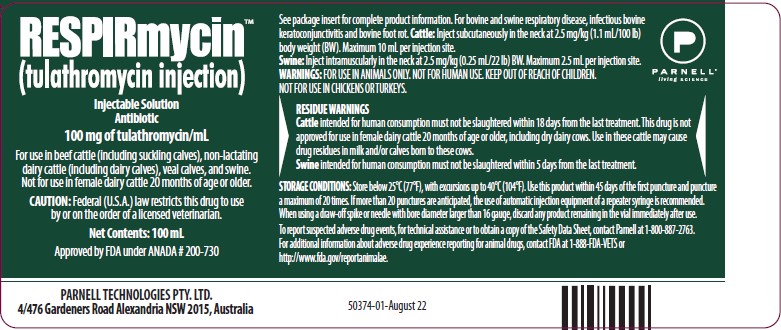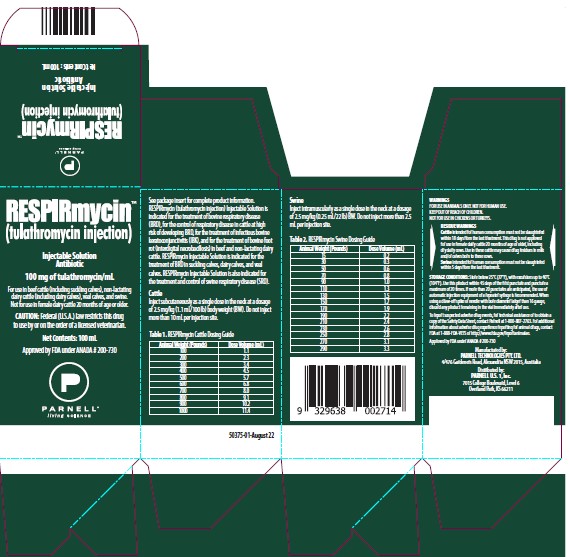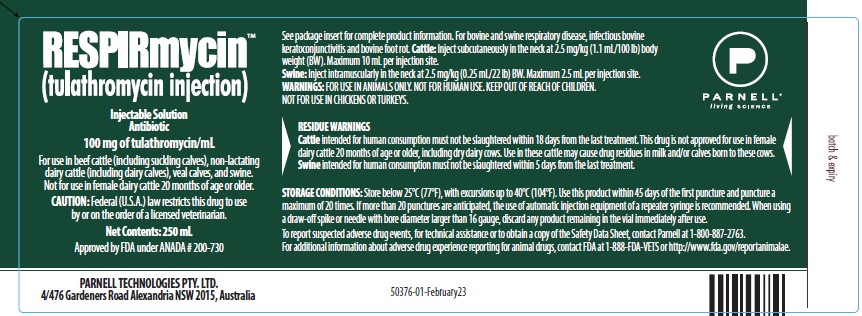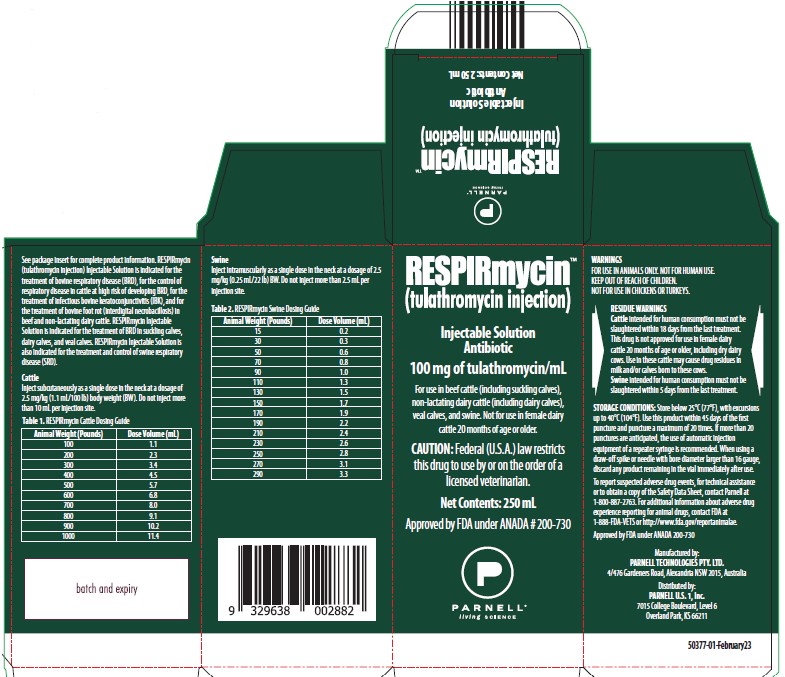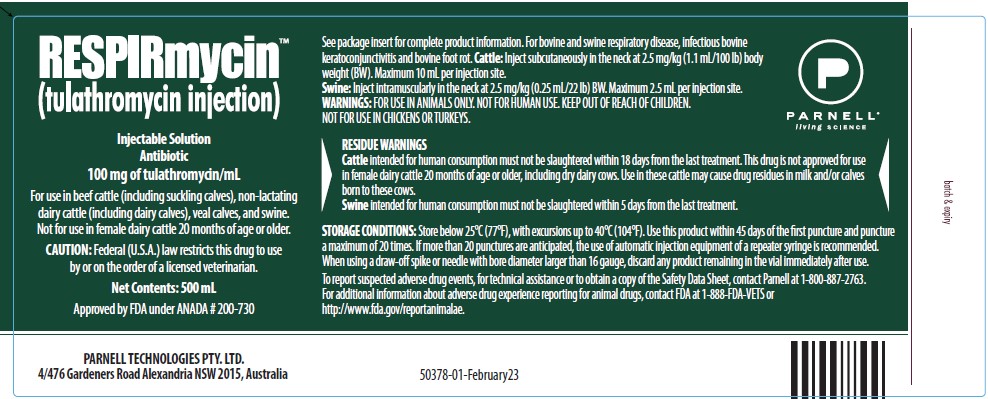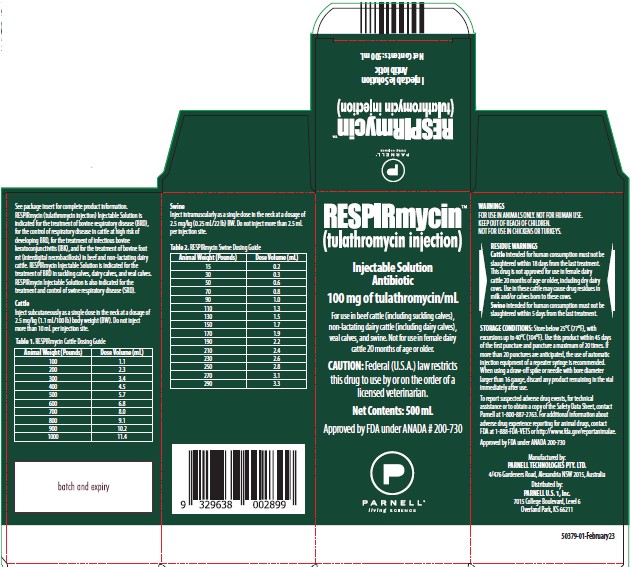Animal NDC 68504-004-02 Respirmycin
Tulathromycin
Animal Product Information
| Field Name | Field Value |
|---|---|
| Animal NDC Code | 68504-004-02 |
| Proprietary Name | Respirmycin What is the Proprietary Name? The proprietary name also known as the trade name is the name of the product chosen by the medication labeler for marketing purposes. |
| Non-Proprietary Name | Tulathromycin What is the Non-Proprietary Name? The non-proprietary name is sometimes called the generic name. The generic name usually includes the active ingredient(s) of the product. |
| Labeler Name | Parnell Technologies Pty Ltd |
| Product Type | Prescription Animal Drug |
| Usage Information |
|
| Active Ingredient(s) |
|
| Inactive Ingredient(s) |
|
| Marketing Category | ANADA - ABBREVIATED NEW ANIMAL DRUG APPLICATION What is the Marketing Category? Product types are broken down into several potential Marketing Categories, such as NDA/ANDA/BLA, OTC Monograph, or Unapproved Drug. One and only one Marketing Category may be chosen for a product, not all marketing categories are available to all product types. Currently, only final marketed product categories are included. The complete list of codes and translations can be found at www.fda.gov/edrls under Structured Product Labeling Resources. |
| FDA Application Number | ANADA200730 What is the FDA Application Number? This corresponds to the NDA, ANDA, or BLA number reported by the labeler for products which have the corresponding Marketing Category designated. If the designated Marketing Category is OTC Monograph Final or OTC Monograph Not Final, then the Application number will be the CFR citation corresponding to the appropriate Monograph (e.g. “part 341”). For unapproved drugs, this field will be null. |
Respirmycin Animal Product Labeling Information
The product labeling information includes all published material associated to a drug. Product labeling documents include information like generic names, active ingredients, ingredient strength dosage, routes of administration, appearance, usage, warnings, inactive ingredients, etc.
Table of Contents
- Other
- Description
- Indications & Usage
- Dosage & Administration
- Contraindications
- Warnings And Precautions
- Adverse Reactions
- Postmarketing Experience
- Clinical Pharmacology
- Microbiology
- Storage And Handling
- How Supplied
- Principle Display Panel - 50 Ml Bottle
- Principle Display Panel - 50 Ml Carton
- Principle Display Panel - 100 Ml Bottle
- Principle Display Panel - 100 Ml Carton
- Principle Display Panel - 250 Ml Bottle
- Principle Display Panel - 250 Ml Carton
- Principle Display Panel - 500 Ml Bottle
- Principle Display Panel - 500 Ml Carton
Other
RESPIRmycin™
(tulathromycin injection)
Injectable Solution
Antibiotic
100 mg of tulathromycin/mL
For use in beef cattle (including suckling calves), non-lactating dairy cattle (including dairy calves), veal calves, and swine. Not for use in female dairy cattle 20 months of age or older.
CAUTION: Federal (USA) law restricts this drug to use by or on the order of a licensed veterinarian.
Description
DESCRIPTION
RESPIRmycin Injectable Solution is a ready-to-use sterile parenteral preparation containing tulathromycin, a semi-synthetic macrolide antibiotic of the subclass triamilide. Each mL of RESPIRmycin contains 100 mg of tulathromycin, 500 mg propylene glycol, 19.2 mg citric acid and 5 mg monothioglycerol. Sodium hydroxide or hydrochloric acid may be added to adjust pH. RESPIRmycin consists of an equilibrated mixture of two isomeric forms of tulathromycin in a 9:1 ratio. Structures of the isomers are shown below.
The chemical names of the isomers are (2R,3S,4R,5R,8R,10R,11R,12S,13S,14R)-13-[[2,6-dideoxy-3-C-methyl-3-O-methyl-4-C-[(propylamino) methyl]-α-L-ribo-hexopyrano-syl]oxy]-2-ethyl-3,4,10-trihydroxy-3,5,8,10,12,14-hexamethyl-11-[[3,4,6-trideoxy-3-(dimethylamino)-β-D-xylo-hexopyranosyl]-oxy]-1-oxa-6-azacyclopentadecan-15-one and (2R,3R,6R,8R,9R,10S,11S,12R)-11-[[2,6-dideoxy-3-C-methyl- 3-O-methyl-4-C-[(propylamino)methyl]- α-L-ribo-hexopyrano-syl]oxy]-2-[(1R,2R)-1,2-dihydroxy-1-methylbutyl]-8-hydroxy-3,6,8,10,12-pentamethyl-9-[[3,4,6-trideoxy-3-(dimethylamino)-β-D-xylo-hexopyranosyl]oxy]-1-oxa-4-azacyclotridecan-13-one, respectively.
Indications & Usage
INDICATIONS
Beef and Non-Lactating Dairy Cattle
BRD – RESPIRmycin Injectable Solution is indicated for the treatment of bovine respiratory disease
(BRD) associated with Mannheimia haemolytica, Pasteurella multocida, Histophilus somni, and
Mycoplasma bovis; and for the control of respiratory disease in cattle at high risk of developing BRD
associated with Mannheimia haemolytica, Pasteurella multocida, Histophilus somni, and Mycoplasma
bovis.
IBK – RESPIRmycin Injectable Solution is indicated for the treatment of infectious bovine
keratoconjunctivitis (IBK) associated with Moraxella bovis.
Foot Rot – RESPIRmycin Injectable Solution is indicated for the treatment of bovine foot rot
(interdigital necrobacillosis) associated with Fusobacterium necrophorum and Porphyromonas levii.
Suckling Calves, Dairy Calves, and Veal Calves
BRD – RESPIRmycin Injectable Solution is indicated for the treatment of BRD associated with
M. haemolytica, P. multocida, H. somni, and M. bovis.
Swine
RESPIRmycin Injectable Solution is indicated for the treatment of swine respiratory disease (SRD)
associated with Actinobacillus pleuropneumoniae, Pasteurella multocida, Bordetella bronchiseptica,
Haemophilus parasuis, and Mycoplasma hyopneumoniae; and for the control of SRD associated with
Actinobacillus pleuropneumoniae, Pasteurella multocida, and Mycoplasma hyopneumoniae in groups of
pigs where SRD has been diagnosed.
Dosage & Administration
DOSAGE AND ADMINISTRATION
Cattle
Inject subcutaneously as a single dose in the neck at a dosage of 2.5 mg/kg (1.1 mL/100 lb) body weight
(BW). Do not inject more than 10 mL per injection site.
Table 1. RESPIRmycin Cattle Dosing Guide
| Animal Weight (Pounds) | Dose Volume (mL) |
| 100 | 1.1 |
| 200 | 2.3 |
| 300 | 3.4 |
| 400 | 4.5 |
| 500 | 5.7 |
| 600 | 6.8 |
| 700 | 8.0 |
| 800 | 9.1 |
| 900 | 10.2 |
| 1000 | 11.4 |
Swine
Inject intramuscularly as a single dose in the neck at a dosage of 2.5 mg/kg (0.25 mL/22 lb) BW.
Do not inject more than 2.5 mL per injection site.
Table 2. RESPIRmycin Swine Dosing Guide
| Animal Weight (Pounds) | Dose Volume (mL) |
| 15 | 0.2 |
| 30 | 0.3 |
| 50 | 0.6 |
| 70 | 0.8 |
| 90 | 1.0 |
| 110 | 1.3 |
| 130 | 1.5 |
| 150 | 1.7 |
| 170 | 1.9 |
| 190 | 2.2 |
| 210 | 2.4 |
| 230 | 2.6 |
| 250 | 2.8 |
| 270 | 3.1 |
| 290 | 3.3 |
Contraindications
CONTRAINDICATIONS
The use of RESPIRmycin Injectable Solution is contraindicated in animals previously found to be hypersensitive to the drug.
Warnings And Precautions
WARNINGS
FOR USE IN ANIMALS ONLY.
NOT FOR HUMAN USE.
KEEP OUT OF REACH OF CHILDREN.
NOT FOR USE IN CHICKENS OR TURKEYS.
RESIDUE WARNINGS
Cattle
Cattle intended for human consumption must not be slaughtered within 18 days from the last treatment. This drug is not approved for use in female dairy cattle 20 months of age or older, including dry dairy cows. Use in these cattle may cause drug residues in milk and/or in calves born to these cows.
Swine
Swine intended for human consumption must not be slaughtered within 5 days from the last treatment.
PRECAUTIONS
Cattle
The effects of RESPIRmycin on bovine reproductive performance, pregnancy, and lactation have not been determined. Subcutaneous injection can cause a transient local tissue reaction that may result in trim loss of edible tissue at slaughter.
Swine
The effects of RESPIRmycin on porcine reproductive performance, pregnancy, and lactation have not been determined. Intramuscular injection can cause a transient local tissue reaction that may result in trim loss of edible tissue at slaughter.
Adverse Reactions
ADVERSE REACTIONS
Cattle
In one BRD field study, two calves treated with tulathromycin injection at 2.5 mg/kg BW exhibited transient hypersalivation. One of these calves also exhibited transient dyspnea, which may have been related to pneumonia.
Swine
In one field study, one out of 40 pigs treated with tulathromycin injection at 2.5 mg/kg BW exhibited mild salivation that resolved in less than four hours.
Postmarketing Experience
POST APPROVAL EXPERIENCE
The following adverse events are based on post approval adverse drug experience reporting. Not all adverse events are reported to the FDA CVM. It is not always possible to reliably estimate the adverse event frequency or establish a causal relationship to product exposure using these data. The following adverse events are listed in decreasing order of reporting frequency in cattle: Injection site reactions and anaphylaxis/anaphylactoid reactions. For a complete listing of adverse reactions for tulathromycin injection injectable solution reported to the CVM see: www.fda.gov/reportanimalae.
Clinical Pharmacology
CLINICAL PHARMACOLOGY
At physical pH, tulathromycin (a weak base) is approximately 50 times more soluble in hydrophilic than hydrophobic media. This solubility profile is consistent with the extracellular pathogen activity typically associated with the macrolides.1 Markedly higher tulathromycin concentrations are observed in the lungs as compared to plasma. The extent to which lung concentrations represent free (active) drug was not examined. Therefore, the clinical relevance of these elevated lung concentrations is undetermined.
Although the relationship between tulathromycin and the characteristics of its antimicrobial effects has not been characterized, as a class, macrolides tend to be primarily bacteriostatic, but may be bactericidal against some pathogens.2 They also tend to exhibit concentration independent killing; the rate of bacterial eradication does not change once serum drug concentrations reach 2 to 3 times the minimum inhibitory concentration (MIC) of the targeted pathogen. Under these conditions, the tiime that serum concentrations remain above the MIC becomes the major determinant of antimicrobial activity. Macrolides also exhibit a post-antibiotic effect (PAE), the duration of which tends to be both drug and pathogen dependent. In general, by increasing the macrolide concentration and the exposure time, the PAE will increase to some maximal duration. Of the two variables, concentrration and exposure time, drug concentration tends to be the most powerful determinant of the duration of PAE.
Tulathromycin is eliminated from the body primarily unchanged via biliary excretion.
1Carbon, C. 1998. Pharmacodynamics of Macrolides, Azalides, and Streptogramins: Effect on Extracellular Pathogens. Clin. Infect. Dis., 27:28-32.
2Nightingale, C.J. 1997. Pharacokinetics and Pharmacodynamics of Newer Macrolides. Pediatr. Infect. Dis. J., 16:438-443.
Cattle
Following subcutaneous administration into the neck of feeder calves at a dosage of 2.5 mg/kg BW, tulathromycin is rapidly and nearly completely absorbed. Peak plasma concentrations generally occur within 15 minutes after dosing and product relative bioavailability exceeds 90%. Total systemic clearance is approximately 170 mL/hr/kg. Tulathromycin distributes extensively into body tissues, as evidenced by volume of distribution values of approximately 11 L/kg in healthy ruminating calves.3 This extensive volume of distribution is largely responsible for the long elimination half-life of this compound [approximately 2.75 days in the plasma (based on quantifiable terminal plasma drug concentrations) versus 8.75 days for total lung concentrations (based on data from healthy animals)]. Linear pharmacokinetics are observed with subcutaneous doses ranging from 1.27 mg/kg BW to 5.0 mg/kg BW. No pharmacokinetic differences are observed in castrated male versus female calves.
3Clearance and volume estimates are based on intersubject comparisons of 2.5 mg/kg BW administered by either subcutaneous or intravenous injection.
Swine
Following intramuscular administration to feeder pigs at a dosage of 2.5 mg/kg BW, tulathromycin is completely and rapidly absorbed (Tmax ~0.25 hour). Subsequently, the drug rapidly distributes into body tissues, achieving a volume of distribution exceeding 15 L/kg. The free drug is rapidly cleared from the systemic circulation (CLsystemic = 187 mL/hr/kg). However, it has a long terminal elimination half-life (60 to 90 hours) owing to its extensive volume of distribution. Although pulmonary tulathromycin concentrations are substantially higher than concentrations observed in the plasma, the clinical significance of these findings is undetermined. There are no gender differences in swine tulathromycin pharmacokinetics.
Microbiology
MICROBIOLOGY
Cattle
Tulathromycin has demonstrated in vitro activity against Mannheimia haemolytica, Pasteurella multocida, Histophilus somni, and Mycoplasma bovis, four pathogens associated with BRD; against Moraxella bovis associated with IBK; and against Fusobacterium necrophorum and Porphyromonas levii associated with bovine foot rot.
The MICs of tulathromycin against indicated BRD and IBK pathogens were determined using methods recommended by the Clinical and Laboratory Standards Institute (CLSI, M31-A2). The MICs against foot rot pathogens were also determined using methods recommended by the CLSI (M11-A6). All MIC values were determined using the 9:1 isomer ratio of this compound.
BRD The MICs of tulathromycin were determined for BRD isolates obtained from calves enrolled in therapeutic and at-risk field studies in the U.S. in 1999. In the therapeutic studies, isolates were obtained from pre-treatment nasopharyngeal swabs from all study calves, and from lung swabs or lung tissue of saline-treated calves that died. In the at-risk studies, isolates were obtained from nasopharyngeal swabs of saline-treated non-responders, and from lung swabs or lung tissue of saline-treated calves that died.
The results are shown in Table 3.
IBK - The MICs of tulathromycin were determined for Moraxella bovis isolates obtained from calves enrolled in IBK field studies in the U.S. in 2004. Isolates were obtained from pretreatment conjunctival swabs of calves with clinical signs of IBK enrolled in the tulathromycin injection and saline-treated groups. The results are shown in Table 3.
Foot Rot - The MICs of tulathromycin were determined for Fusobacterium necrophorum and Porphyromonas levii obtained from cattle enrolled in foot rot field studies in the U.S. and Canada in 2007. Isolates were obtained from pre-treatment interdigital biopsies and swabs of cattle with clinical signs of foot rot enrolled in the tulathromycin injection and saline-treated groups. The results are shown in Table 3.
Table 3. Tulathromycin minimum inhibitory concentration (MIC) values* for indicated pathogens isolated from field studies evaluating BRD and IBK in the U.S. and from foot rot field studies in the U.S. and Canada.
| Indicated pathogen | Date Isolated | No. of isolates | MIC50** (μg/mL) | MIC90** (μg/mL) | MIC range (μg/mL) |
| Mannheimia haemolytica | 1999 | 642 | 2 | 2 | 0.5 to 64 |
| Pasteurella multocida | 1999 | 221 | 0.5 | 1 | 0.25 to 64 |
| Histophilus somni | 1999 | 36 | 4 | 4 | 1 to 4 |
| Mycoplasma bovis | 1999 | 43 | 0.125 | 1 | ≤ 0.063 to > 64 |
| Moraxella bovis | 2004 | 55 | 0.5 | 0.5 | 0.25 to 1 |
| Fusobacterium necrophorum | 2007 | 116 | 2 | 64 | ≤ 0.25 to > 128 |
| Porphyromonas levii | 2007 | 103 | 8 | 128 | ≤ 0.25 to > 128 |
* The correlation between in vitro susceptibility data and clinical effectiveness is unknown.
** The lowest MIC to encompass 50% and 90% of the most susceptible isolates, respectively.
Swine
In vitro activity of tulathromycin has been demonstrated against Actinobacillus pleuropneumoniae, Pasteurella multocida, Bordetella bronchiseptica, Haemophilus parasuis, and Mycoplasma hyopneumoniae.
The MICs of tulathromycin against indicated SRD pathogens were determined using methods recommended by the Clinical and Laboratory Standards Institute (CLSI, M31-A and M31-A3). MICs for Haemophilus parasuis were determined using Veterinary Fastidious Medium and were incubated up to 48 hours at 35 to 37°C in a CO2-enriched atmosphere. All MIC values were determined using the 9:1 isomer ratio of this compound. Isolates obtained in 2000 and 2002 were from lung samples from saline-treated pigs and non-treated sentinel pigs enrolled in Treatment of SRD field studies in the U.S. and Canada. Isolates obtained in 2007 and 2008 were from lung samples from saline-treated and tulathromycin injection-treated pigs enrolled in the Control of SRD field study in the U.S. and Canada. The results are shown in Table 4.
Table 4. Tulathromycin minimum inhibitory concentration (MIC) values* for indicated pathogens isolated from field studies evaluating SRD in the U.S. and Canada.
| Indicated pathogen | Date Isolated | No. of isolates | MIC50** (μg/mL) | MIC90** (μg/mL) | MIC range (μg/mL) |
| Actinobacillus pleuropneumoniae | 2000-2002 2007-2008 | 135 88 | 16 16 | 32 16 | 16 to 32 4 to 32 |
| Haemophilus parasuis | 2000-2002 | 31 | 1 | 2 | 0.25 to >64 |
| Pasteurella multocida | 2000-2002 2007-2008 | 55 40 | 1 1 | 2 2 | 0.5 to >64 ≤ 0.03 to 2 |
| Bordetella bronchiseptica | 2000-2002 | 42 | 4 | 8 | 2 to 8 |
* The correlation between in vitro susceptibility data and clinical effectiveness is unknown.
** The lowest MIC to encompass 50% and 90% of the most susceptible isolates, respectively.
Storage And Handling
STORAGE CONDITIONS
Store below 25°C (77°F), with excursions up to 40°C (104°F). Use this product within 45 days of the first puncture and puncture a maximum of 20 times. If more than 20 punctures are anticipated, the use of automatic injection equipment of a repeater syringe is recommended. When using a draw-off spike or needle with bore diameter larger than 16 gauge, discard any product remaining in the vial immediately after use.
To report suspected adverse drug events, for technical assistance or to obtain a copy of the Safety Data Sheet, contact Parnell at 1-800-887- 763. For additional information about adverse drug experience reporting for animal drugs, contact FDA at 1-888-FDA-VETS or http://www.fda.gov/reportanimalae.
How Supplied
HOW SUPPLIED
RESPIRmycin (tulathromycin injection) Injectable Solution is available in the following package sizes:
50 mL vial
100 mL vial
250 mL vial
500 mL vial
Approved by FDA under ANADA # 200-730
Manufactured by:
PARNELL TECHNOLOGIES PTY. LTD.
4/476 Gardeners Road
Alexandria NSW 2015 Australia
Distributed by:
PARNELL U.S. 1, Inc.
7015 College Boulevard, Level 6,
Overland Park, KS, 66211
50373b-01-August 22
50375b-01-August 22
50377b-01-February23
50379b-01-February23
Principle Display Panel - 50 Ml Bottle
RESPIRmycin™
(tulathromycin injection)
Injectable Solution
Antibiotic
100 mg of tulathromycin/mL
For use in beef cattle (including suckling calves), non-lactating
dairy cattle (including dairy calves), veal calves, and swine.
Not for use in female dairy cattle 20 months of age or older.
CAUTION: Federal (U.S.A.) law restricts this drug to use
by or on the order of a licensed veterinarian.
Net Contents: 50 mL
Approved by FDA under ANADA # 200-730
PARNELL TECHNOLOGIES PTY. LTD.
4/476 Gardeners Road Alexandria NSW 2015, Australia
Principle Display Panel - 50 Ml Carton
RESPIRmycin™
(tulathromycin injection)
Injectable Solution
Antibiotic
100 mg of tulathromycin/mL
For use in beef cattle (including suckling calves), non-lactating
dairy cattle (including dairy calves), veal calves, and swine.
Not for use in female dairy cattle 20 months of age or older.
CAUTION: Federal (U.S.A.) law restricts this drug to use
by or on the order of a licensed veterinarian.
Net Contents: 50 mL
Approved by FDA under ANADA # 200-730
PARNELL®
living SCIENCE
Principle Display Panel - 100 Ml Bottle
RESPIRmycin™
(tulathromycin injection)
Injectable Solution
Antibiotic
100 mg of tulathromycin/mL
For use in beef cattle (including suckling calves), non-lactating
dairy cattle (including dairy calves), veal calves, and swine.
Not for use in female dairy cattle 20 months of age or older.
CAUTION: Federal (U.S.A.) law restricts this drug to use
by or on the order of a licensed veterinarian.
Net Contents: 100 mL
Approved by FDA under ANADA # 200-730
PARNELL TECHNOLOGIES PTY. LTD.
4/476 Gardeners Road Alexandria NSW 2015, Australia
Principle Display Panel - 100 Ml Carton
RESPIRmycin™
(tulathromycin injection)
Injectable Solution
Antibiotic
100 mg of tulathromycin/mL
For use in beef cattle (including suckling calves), non-lactating
dairy cattle (including dairy calves), veal calves, and swine.
Not for use in female dairy cattle 20 months of age or older.
CAUTION: Federal (U.S.A.) law restricts this drug to use
by or on the order of a licensed veterinarian.
Net Contents: 100 mL
Approved by FDA under ANADA # 200-730
PARNELL®
living SCIENCE
Principle Display Panel - 250 Ml Bottle
RESPIRmycin™
(tulathromycin injection)
Injectable Solution
Antibiotic
100 mg of tulathromycin/mL
For use in beef cattle (including suckling calves), non-lactating
dairy cattle (including dairy calves), veal calves, and swine.
Not for use in female dairy cattle 20 months of age or older.
CAUTION: Federal (U.S.A.) law restricts this drug to use
by or on the order of a licensed veterinarian.
Net Contents: 250 mL
Approved by FDA under ANADA # 200-730
PARNELL TECHNOLOGIES PTY. LTD.
4/476 Gardeners Road Alexandria NSW 2015, Australia
Principle Display Panel - 250 Ml Carton
RESPIRmycin™
(tulathromycin injection)
Injectable Solution
Antibiotic
100 mg of tulathromycin/mL
For use in beef cattle (including suckling calves), non-lactating
dairy cattle (including dairy calves), veal calves, and swine.
Not for use in female dairy cattle 20 months of age or older.
CAUTION: Federal (U.S.A.) law restricts this drug to use
by or on the order of a licensed veterinarian.
Net Contents: 250 mL
Approved by FDA under ANADA # 200-730
PARNELL®
living SCIENCE
Principle Display Panel - 500 Ml Bottle
RESPIRmycin™
(tulathromycin injection)
Injectable Solution
Antibiotic
100 mg of tulathromycin/mL
For use in beef cattle (including suckling calves), non-lactating
dairy cattle (including dairy calves), veal calves, and swine.
Not for use in female dairy cattle 20 months of age or older.
CAUTION: Federal (U.S.A.) law restricts this drug to use
by or on the order of a licensed veterinarian.
Net Contents: 500 mL
Approved by FDA under ANADA # 200-730
PARNELL TECHNOLOGIES PTY. LTD.
4/476 Gardeners Road Alexandria NSW 2015, Australia
Principle Display Panel - 500 Ml Carton
RESPIRmycin™
(tulathromycin injection)
Injectable Solution
Antibiotic
100 mg of tulathromycin/mL
For use in beef cattle (including suckling calves), non-lactating
dairy cattle (including dairy calves), veal calves, and swine.
Not for use in female dairy cattle 20 months of age or older.
CAUTION: Federal (U.S.A.) law restricts this drug to use
by or on the order of a licensed veterinarian.
Net Contents: 500 mL
Approved by FDA under ANADA # 200-730
PARNELL®
living SCIENCE
* The information on this page is for an ANIMAL PRODUCT, please review the complete disclaimer below.
